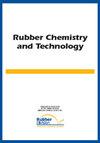EFFECT OF MOLECULAR ENVIRONMENT ON PROTEIN RUBBER PROPERTIES
IF 1.5
4区 工程技术
Q4 POLYMER SCIENCE
引用次数: 0
Abstract
Many natural organisms use “protein rubbers” to store and release an imposed strain energy with high efficiency to make motion easier. Protein rubbers exist in a complicated environment surrounded by water and other molecules such as sugars, implying that amino acid composition and its environment are important in protein rubber behavior. Here, gelatin, the hydrolysis product of animal collagen, is hydrated or “plasticized” with water, ethylene glycol, glycerol, corn syrup, and aqueous solutions of sorbitol, glucose, and fructose. The rubber formed is “dry”, that is, is not fully immersed in liquid, and has the appearance and feel of a soft rubber band. The mechanical and thermodynamic behavior of each rubber is characterized with low strain dynamic and high strain tensile experiments with good agreement between the two. Plasticized gelatin rubbers are incompressible and follow the neo-Hookean model for rubber elasticity up to moderate extension ratios. Higher molecular weight polyols with more hydrogen bond donors and acceptors create gelatin networks with lower crosslink density. Ethylene glycol–, glycerol-, sorbitol syrup–, and fructose syrup–plasticized gelatin rubbers have similar molecular relaxation mechanisms and are the most efficient rubbers when probed in the rubbery plateau region prior to approaching the glass transition. The other plasticizers have different molecular relaxation mechanisms that detract from the efficiency of energy storage and return that is not related to network formation but perhaps the individual solvation ability of each plasticizer.分子环境对蛋白质橡胶性能的影响
许多天然生物使用“蛋白质橡胶”来高效储存和释放施加的应变能,使运动更容易。蛋白质橡胶存在于被水和糖等其他分子包围的复杂环境中,这意味着氨基酸组成及其环境在蛋白质橡胶行为中很重要。在这里,动物胶原蛋白的水解产物明胶用水、乙二醇、甘油、玉米糖浆和山梨醇、葡萄糖和果糖的水溶液进行水合或“塑化”。形成的橡胶是“干的”,即没有完全浸入液体中,并且具有柔软橡胶带的外观和感觉。通过低应变动态实验和高应变拉伸实验对每种橡胶的力学和热力学行为进行了表征,两者之间具有良好的一致性。增塑明胶橡胶是不可压缩的,并遵循新胡克模型的橡胶弹性高达中等拉伸比。具有更多氢键供体和受体的高分子量多元醇产生具有较低交联密度的明胶网络。乙二醇、甘油、山梨醇糖浆和果糖糖浆增塑的明胶橡胶具有类似的分子弛豫机制,并且在接近玻璃化转变之前在橡胶平台区域进行探测时是最有效的橡胶。其他增塑剂具有不同的分子弛豫机制,这降低了能量存储和返回的效率,这与网络形成无关,但可能与每种增塑剂的单独溶剂化能力有关。
本文章由计算机程序翻译,如有差异,请以英文原文为准。
求助全文
约1分钟内获得全文
求助全文
来源期刊

Rubber Chemistry and Technology
工程技术-高分子科学
CiteScore
3.50
自引率
20.00%
发文量
21
审稿时长
3.6 months
期刊介绍:
The scope of RC&T covers:
-Chemistry and Properties-
Mechanics-
Materials Science-
Nanocomposites-
Biotechnology-
Rubber Recycling-
Green Technology-
Characterization and Simulation.
Published continuously since 1928, the journal provides the deepest archive of published research in the field. Rubber Chemistry & Technology is read by scientists and engineers in academia, industry and government.
 求助内容:
求助内容: 应助结果提醒方式:
应助结果提醒方式:


